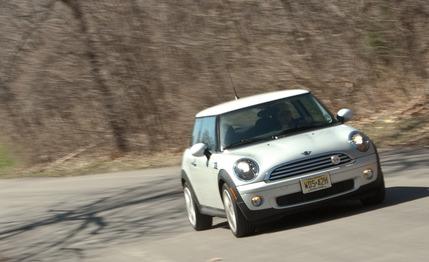
 Quick Test
Quick Test
What Is It?
The Terrain is GMC’s new compact SUV. Built on a unibody platform shared with the Chevrolet Equinox, it’s GMC’s smallest current offering but also one of its quietest and most comfortable. Base versions—starting at $24,995—are powered by a 2.4-liter inline-four, but that engine is pretty wheezy when tasked with moving the Terrain’s two-plus tons. We recommend the V-6. Both engines are available with either front- or all-wheel drive.
How Does It Drive?
People don't buy a vehicle like this for its handling prowess. If they did, the Terrain wouldn’t sell for crap, and neither would most of its competition. Even in an uninspiring class, the Terrain is among the most relaxed. The steering is numb, the body totters through turns, the chassis quickly gets confused in rapid transitions, and the brake pedal is disconcertingly squishy. We somehow managed a Superman stop from 70 mph in just 161 feet with the front-wheel-drive Terrain—that’s BMW M3 territory—but this all-wheel-drive version Clark Kented to a halt in a more pedestrian 186.
The 3.0-liter V-6 is unusually peaky for a GM engine, with the full 264 hp waiting until 6950 rpm to assemble and 222 lb-ft of torque not being realized until 5100 rpm. Quickness is decidedly midpack, with the 0-to-60-mph sprint taking 8.4 seconds. The reason for choosing a small ute over something larger is typically fuel economy, but the EPA rates this Terrain at just 17 mpg in the city and 24 on the highway, figures matched by GMC’s own Acadia three-row SUV. We needed a gallon of regular every 22 miles. (Front-drive Terrains with the V-6 are rated at 17/25; four-cylinder models have ratings of 22/32 and 20/29 for front- and all-wheel drive, respectively.)
How Does It Stack Up?
Interior design is increasingly becoming a GM strong suit, and the leather-lined SLT-1 and SLT-2 trims of the GMC Terrain are unquestionably the truck division’s finest interiors ever. Our tester’s Brownstone pebbled dash looks so much like a football that gridiron groupies and yesterday’s star quarterbacks will be endlessly running their hands over it.
That’s not to say GMC’s work is done. A few cheap parts remain. The lid to the dash-top storage bin feels so cheap it’s probably toxic, panel gaps here and there are big enough to hide your hand, and the red dot-matrix radio readout parrots a theme pioneered by early-’90s Pontiacs. But the overall design is extremely well done, and the quality of the materials is surprising—in a good way. The rear bench seat adjusts fore-and-aft several inches to accommodate taller passengers or more thoroughly stuffed suitcases in the cargo area behind. (We imagine most people will slide it all the way back and then forget it adjusts, as we did.) Thanks to the sluggish dynamics, a Terrain finished sixth out of eight in a recent small-ute shootout.
Although the Terrain is pitched against the Honda CR-V and Toyota RAV4, it’s a little bigger, and its blocky styling makes it look more so, to the point that it begs comparisons with vehicles in the same class such as the Ford Edge and Nissan Murano. However, the Terrain’s interior volume is just average for the small class and doesn’t fare well against the space available in larger vehicles.
What’s the Cost?
As noted earlier, Terrains start at $24,995. All-wheel drive adds $1750 to the price, and the V-6 is $1500. Our SLT-2 tester ($32,045 base) had few extras in addition to the V-6—just the $245 cargo-management bundle and the $350 trailer-prep package, for a total of $34,140. For shoppers setting practicality or pigskin-esque dashboards as priorities, the Terrain is a satisfactory buy, although something a little lighter than this GMC’s 4190 pounds would probably be a little lighter on gas as well.